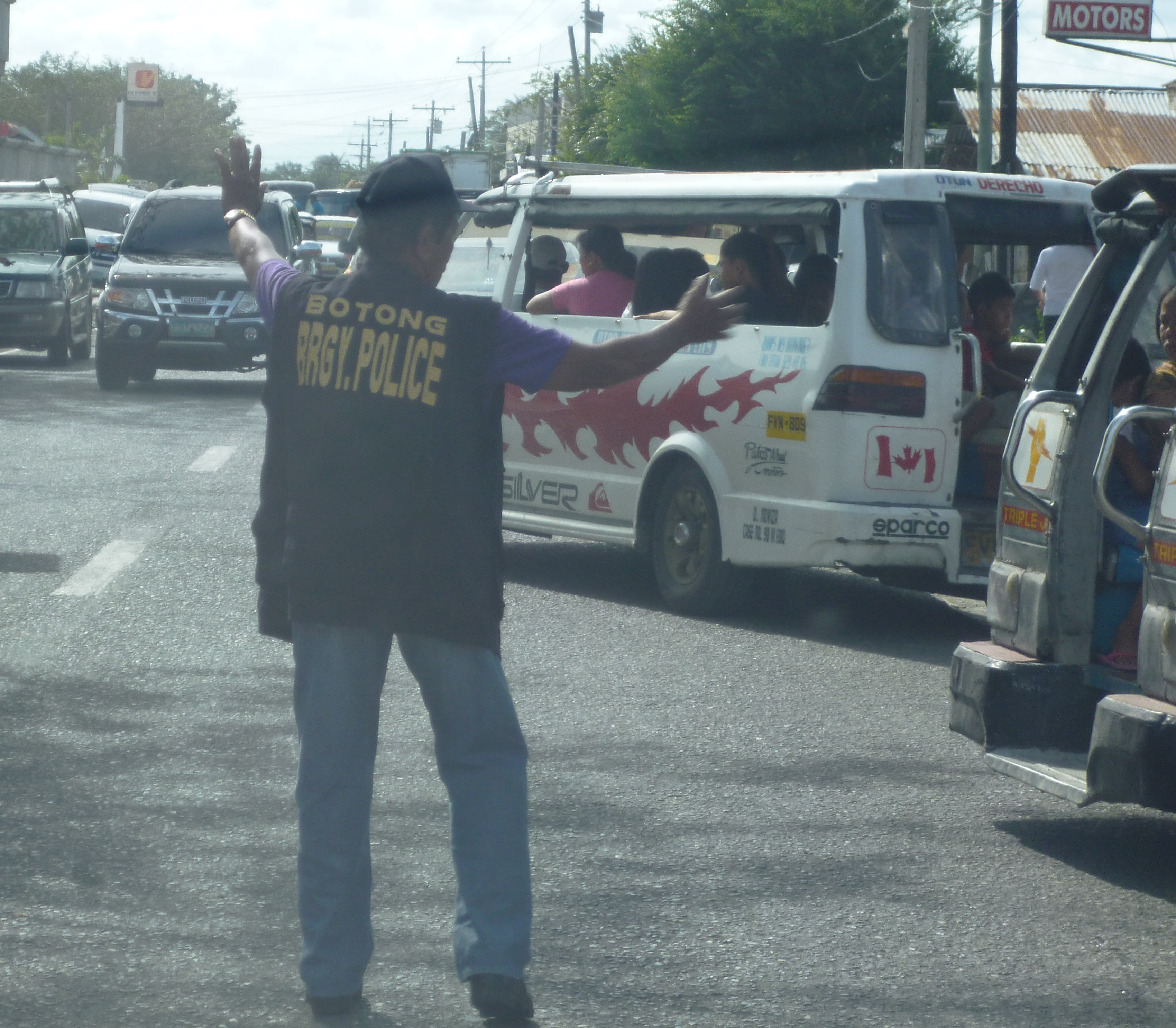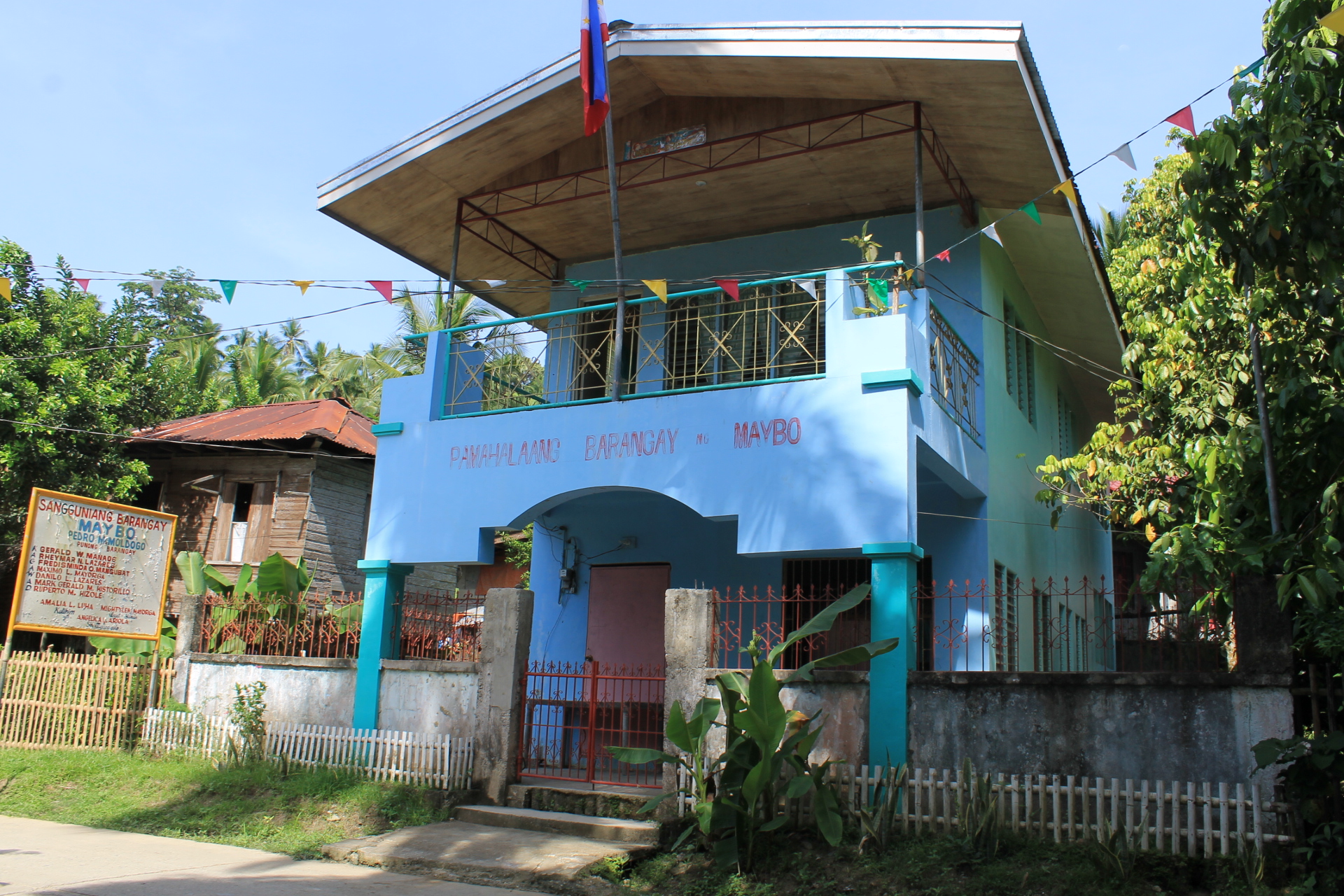|
Tanod
A barangay tanod, also known as a barangay police officer – and sometimes as BPSO (which can stand for barangay public safety officer, barangay peacekeeping and security officer, or barangay police safety officer) – is the lowest level of law enforcement officer in the Philippines. He is a watchman for a barangay who is supervised by the barangay captain and performs a variety of police functions. Tanods are "front liners in the preparation and response to any type of atrocities, public disorders, emergencies and even disasters or man-made calamities that threaten peace and order and public safety." They may be unarmed or armed with a baton or bolo knife (a type of machete). Duties While tanods cooperate with the Philippine National Police (PNP), they are not a part of the PNP. They do not have the same authority as police officers. Rather, tanods augment the police and fulfill "certain functions which the police force cannot immediately discharge especially with respect ... [...More Info...] [...Related Items...] OR: [Wikipedia] [Google] [Baidu] |
Barangay
A barangay (; abbreviated as Brgy. or Bgy.), historically referred to as barrio (abbreviated as Bo.), is the smallest administrative division in the Philippines and is the native Filipino term for a village, district, or ward. In metropolitan areas, the term often refers to an inner city neighborhood, a suburb, or a suburban neighborhood or even a borough. The word ''barangay'' originated from '' balangay'', a type of boat used by a group of Austronesian peoples when they migrated to the Philippines. Municipalities and cities in the Philippines are politically subdivided into barangays, with the exception of the municipalities of Adams in Ilocos Norte and Kalayaan in Palawan, with each containing a single barangay. Barangays are sometimes informally subdivided into smaller areas called ''purok'' ( en, " zone"), or barangay zones consisting of a cluster of houses for organizational purposes, and '' sitios'', which are territorial enclaves—usually rural—far from th ... [...More Info...] [...Related Items...] OR: [Wikipedia] [Google] [Baidu] |
Barangays Of The Philippines
A barangay (; abbreviated as Brgy. or Bgy.), historically referred to as barrio (abbreviated as Bo.), is the smallest administrative division in the Philippines and is the native Filipino term for a village, district, or ward. In metropolitan areas, the term often refers to an inner city neighborhood, a suburb, or a suburban neighborhood or even a borough. The word ''barangay'' originated from ''balangay'', a type of boat used by a group of Austronesian peoples when they migrated to the Philippines. Municipalities and cities in the Philippines are politically subdivided into barangays, with the exception of the municipalities of Adams in Ilocos Norte and Kalayaan in Palawan, with each containing a single barangay. Barangays are sometimes informally subdivided into smaller areas called ''purok'' ( en, "zone"), or barangay zones consisting of a cluster of houses for organizational purposes, and ''sitios'', which are territorial enclaves—usually rural—far from the barangay ... [...More Info...] [...Related Items...] OR: [Wikipedia] [Google] [Baidu] |
Watchman (law Enforcement)
Watchmen were organised groups of men, usually authorised by a state, government, city, or society, to deter criminal activity and provide law enforcement as well as traditionally perform the services of public safety, fire watch, crime prevention, crime detection, and recovery of stolen goods. Watchmen have existed since earliest recorded times in various guises throughout the world and were generally succeeded by the emergence of formally organised professional policing. Early origins An early reference to a watch can be found in the Bible where the Prophet Ezekiel states that it was the duty of the watch to blow the horn and sound the alarm. (Ezekiel 33:1-6) The Roman Empire made use of the Praetorian Guard and the Vigiles, literally the watch. Watchmen in England The problem of the night The streets in London were dark and had a shortage of and poor quality artificial light. It had been recognised for centuries that the coming of darkness to the unlit streets of a ... [...More Info...] [...Related Items...] OR: [Wikipedia] [Google] [Baidu] |
Philippine Flag
The national flag of the Philippines ( tgl, Pambansang watawat ng Pilipinas; ilo, Nailian a bandera ti Filipinas; ceb, Nasudnong bandila ng Pilipinas; es, Bandera Nacional de Filipinas) is a horizontal List of flags by design#Bicolour, bicolor flag with equal bands of royal blue and Crimson, crimson red, with a white, equilateral triangle at the Glossary of vexillology#Flag elements, hoist. In the center of the triangle is a golden-yellow Sun (heraldry), sun with eight primary rays, each representing a Provinces of the Philippines, province. At each vertex of the triangle is a five-pointed, golden-yellow star, each of which representing one of the country's three main island groups—Luzon, Visayas (though originally referring to the island of Panay) and Mindanao. The white triangle at the flag represents liberty, Political egalitarianism, equality, and Fraternity (philosophy), fraternity. A unique feature of this flag is its usage to indicate a state of war if it is displayed ... [...More Info...] [...Related Items...] OR: [Wikipedia] [Google] [Baidu] |
Barangay Hall
A barangay hall is the seat of government for a barangay, the lowest elected administrative division of the Philippines, below that of a city or municipality. It serves as the office of the barangay captain and meeting place for the Sangguniang Barangay. These officers' names, pictures and responsibilities are usually displayed in the hall. The hall can be considered the counterpart to its municipality's municipal hall. The barangay hall also serves as a local community center, often providing space for both permanent and temporary services and events. The barangay's day care center and office space for the tanods and the barangay health workers are often located there. Medical missions, religious services, fiestas, and sports contests are often held near or next to the barangay hall. Gallery A selection of barangay halls: File:Barangay Bilogo Multi-purpose Hall.JPG, The Barangay Bilogo Multi-purpose Hall, Batangas City File:Sulop Barangay Hall.JPG, Sulop Barangay Hall File: ... [...More Info...] [...Related Items...] OR: [Wikipedia] [Google] [Baidu] |
Security Guard
A security guard (also known as a security inspector, security officer, or protective agent) is a person employed by a government or private party to protect the employing party's assets (property, people, equipment, money, etc.) from a variety of hazards (such as criminal activity, waste, damaged property, unsafe worker behavior, etc.) by enforcing preventative measures. Security guards do this by maintaining a high-visibility presence to deter illegal and inappropriate actions, looking (either directly, through patrols, or indirectly, by monitoring alarm systems or video surveillance cameras) for signs of crime or other hazards (such as a fire), taking action to minimize damage (such as warning and escorting trespassers off property), and reporting any incidents to their clients and emergency services (such as the police or paramedics), as appropriate. Security officers are generally uniformed to represent their lawful authority to protect private property. Security guards ... [...More Info...] [...Related Items...] OR: [Wikipedia] [Google] [Baidu] |
Internal Revenue Allotment
The Internal Revenue Allotment (IRA) is a local government unit’s (LGU) share of revenues from the Philippine national government. Provinces, independent cities, component cities, municipalities, and barangays each get a separate allotment. The allotment is largely based upon the type of government they are and a formula based upon their land area and population. Section 284 of the Local Government Code of the Philippines (RA 7160) sets up the formula for the distribution of the allotment. All or nearly all of the revenue that a local government has to spend comes from their IRA, though some local governments also have additional local sources of revenue such as property taxes A property tax or millage rate is an ad valorem tax on the value of a property.In the OECD classification scheme, tax on property includes "taxes on immovable property or net wealth, taxes on the change of ownership of property through inheri ... and government fees. Typically for municipal ... [...More Info...] [...Related Items...] OR: [Wikipedia] [Google] [Baidu] |
Law Enforcement In The Philippines
The Philippine National Police ( fil, Pambansang Pulisya ng Pilipinas, acronymed as PNP) is the armed national police force in the Philippines. Its national headquarters is located at Camp Crame in Bagong Lipunan ng Crame, Quezon City. Currently, it has approximately 220,000 personnel to police a population in excess of 100 million. The agency is administered and controlled by the National Police Commission and is part of the Department of the Interior and Local Government (DILG). Local police officers are operationally controlled by municipal mayors. DILG, on the other hand, organizes, trains and equips the PNP for the performance of police functions as a police force that is national in scope and civilian in character. The PNP was formed on January 29, 1991, when the Philippine Constabulary and the Integrated National Police were merged pursuant to Republic Act 6975 of 1990. [...More Info...] [...Related Items...] OR: [Wikipedia] [Google] [Baidu] |
DILG
The Department of the Interior and Local Government ( fil, Kagawaran ng Interyor at Pamahalaang Lokal), abbreviated as DILG, is the executive department of the Philippine government responsible for promoting peace and order, ensuring public safety and strengthening local government capability aimed towards the effective delivery of basic services to the citizenry. The department is currently led by the secretary of the interior and local government, nominated by the president of the Philippines and confirmed by the Commission on Appointments. The secretary is a member of the Cabinet. The current secretary of the interior and local government is Sec. Benjamin Abalos Jr. History The DILG traces its roots in the Tejeros Convention of March 22, 1897. As the Department of the Interior, it was among the first Cabinet positions of the proposed revolutionary Philippine government, wherein Gen. Emilio Aguinaldo was elected president. The leader of Katipunan's Magdiwang faction, Andr ... [...More Info...] [...Related Items...] OR: [Wikipedia] [Google] [Baidu] |
Local Government In The Philippines
In the Philippines, local government is divided into three levels: provinces and independent cities, component cities and municipalities, and barangays, all of which are collectively known as local government units (LGUs). In one area, above provinces and independent cities, is an autonomous region, the Bangsamoro Autonomous Region in Muslim Mindanao. Below barangays in some cities and municipalities are sitios and puroks. All of these, with the exception of sitios and puroks, elect their own executives and legislatures. Sitios and puroks are often but not necessarily led by an elected barangay councilor. Provinces and independent cities are organized into national government regions but those are administrative regions and not separately governed areas with their own elected governments. According to the Constitution of the Philippines, the local governments "shall enjoy local autonomy", and in which the Philippine president exercises "general supervision". Congress ... [...More Info...] [...Related Items...] OR: [Wikipedia] [Google] [Baidu] |
Iloilo City
Iloilo City, officially the City of Iloilo ( hil, Siyudad/Dakbanwa sang Iloilo; fil, Lungsod ng Iloilo), is a 1st class highly urbanized city in the Western Visayas region of the Philippines on the island of Panay. It is the capital city of the province of Iloilo, where it is geographically situated and grouped under the Philippine Statistics Authority, but remains politically independent in terms of government and administration. In addition, it is the center of the Iloilo–Guimaras Metropolitan Area, as well as the regional center and primate city of the Western Visayas region. According to the 2020 census, Iloilo City has a population of 457,626 people. For the metropolitan area, the total population is 1,007,945 people. Iloilo City is a conglomeration of former towns, which are now the geographical or administrative districts consisting of: Villa de Arevalo, Iloilo City Proper, Jaro (an independent city before), La Paz, Mandurriao, and Molo. The district of La ... [...More Info...] [...Related Items...] OR: [Wikipedia] [Google] [Baidu] |






